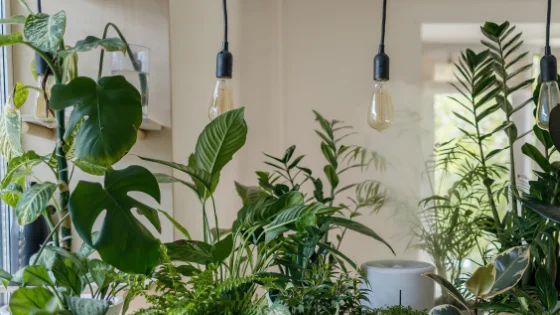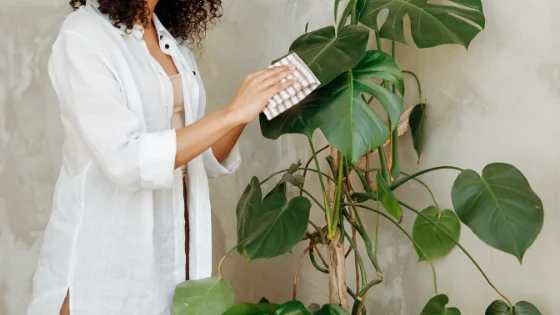How much light does a Monstera need? Well, there is no way to answer definitively. However, I can tell you a lot of things that you might want to consider. And that is what I intend to do.
Today, I will be discussing a few ways you can determine how much light your monstera needs and the mistakes people commonly make when buying lights for their monstera.
Read More: Monstera Leaves Care – A Complete Guide
Table of Contents
How Much Light Does A Monstera Need?
Monsteras need 10-12 hours of light per day, which is optimal in the summer but may be reduced to 8-10 hours per day during the winter months, but will require an increase in humidity level.
If you want your monstera to thrive year-round, you’ll need to plan your lighting schedule properly.
It is necessary to have an artificial light on for at least 12 hours every day if you are using one.
Grow lights should be used for roughly 10-12 hours per day if natural sunshine is not accessible, and then progressively increased to 14 hours of light per day for optimal results.
If at all feasible, place your monstera plant near a window that receives at least four hours of direct sunshine every day. I prefer to use sheer curtains to keep the leaves from being scorched by the sun’s full power.
In the absence of natural light, a grow light is the only alternative.
You can purchase one from a nearby gardening supply shop or on the internet. Due to the fact that monstera plants do not tolerate their leaves being overexposed to sunlight, it is essential that you position the light near to the plant.
Leaf burn and/or browning may occur if the leaves are exposed to too much sunlight. Regularly inspect the leaves for symptoms of burn and, if required, apply a grow light.
Growing monstera under grow lights is less costly than purchasing a new plant, and it will keep the plant healthy and happy!
Read More: Does Monstera Need Direct Sunlight?
What Kind Of Sunlight Does Monstera Need?

Despite the fact that monstera likes bright light, it does not tolerate direct sunlight. Leaf burn and leaf drop may occur if the leaves are exposed to too much light.
If you have a south-facing window, your Monstera can live in low light settings indoors as long as it gets some sunlight ever day. Monsteras thrive in humid areas, even when they are grown inside.
Monsteras are really regarded to be one of the simplest houseplants to maintain – if not the easiest of all houseplants!
Never expose your Monstera to more than 4 hours in direct sunlight. Even though it’s a tropical houseplant, if left out on the patio in the summer heat for an extended amount of time, it’ll be scorched to death.
Read More: Can Monstera Live In Low Light?
Can Monstera Be In Bright Light?
Unlike other vines, monstera has enormous leaves and a stunning growth pattern.
Fenestrations (also known as swiss cheese slices) are what really catches the eye on these beautiful plants. They’re aesthetically pleasing in their own right.
The vines may grow to be rather long, and because they require a great deal of light, they are unlikely to thrive in your little space.
No matter how large your windowsill or patio planter is, the vines will grow on top of it rather than up towards the light, resulting in a plant that is hunting for something to climb. When grown in a bright, sunny window, your monstera will thrive.
Monstera Grow Lights

You may get them at a gardening supply shop or online. If you don’t want to spend money on special lights, you may just use a standard full spectrum light bulb. However, in the winter, when the days are shorter, Monsteras thrive in low light.
Supplementing the light from the window, you may need to run a grow light for 12 hours daily to ensure that the plant gets adequate light throughout the cycle. Keep your lights on for at least 8 hours if you must switch off your lights during the night.
Monstera is unique in that it grows well even in low light conditions.
Any time a Monstera is left in direct sunlight for an extended period of time, it is most likely to suffer branch damage. It is not just the heat of the sun that may cause damage to your Monstera, but also the ultra-violet rays generated by it.
Read More: Can Monstera Grow In Shade?
How Many Hours Of Light Does A Monstera Need?
Because monsteras are native to tropical regions, they will need at least eight to ten hours of sunlight every day in most places.
Monsteras need a lot of bright light to thrive, but too much direct sunshine might cause them to become stooped and lanky. When it comes to keeping your Monstera healthy, make sure it gets enough of indirect bright light or under grow lights.
In order for your Monstera to flourish, it needs at least 12 hours of sunlight each day.
Does My Monstera Need More Light?
When it comes to growing a beautiful, robust monstera, lighting is a critical component. Learning how to tell whether your monstera needs additional light is part of this process.
It is best to place your monstera near a bright window so that the sun’s rays do not directly hit the foliage. Monsteras like bright, indirect sunlight and will thrive in this environment.
An east or south-facing window is the ideal location for a monstera. Your monstera will let you know if it doesn’t receive enough light. If you see any of these symptoms, your monstera is in need of additional sunlight.
Read More: Can Monstera Grow In Artificial Light?
Indications That Your Monstera Wants More Light

Monstera leaves won’t split
- The leaves of your monstera should begin to split if they’ve been around for more than three years.
- After all, it’s one of the most recognizable aspects of monsteras—and the reason why the vast majority of us have them.
- Light is required for this, though. Mature leaves which are completely lacking of holes indicate that your monstera might benefit from additional light.
It Takes A Long Time For Soil To Dry Out.
As long as they don’t get their roots soaking wet, monsteras are OK with moderate watering. When the top two inches of soil feel dry to the touch, you should begin watering. To test the soil, stick your finger into it. You need to water your plant if the soil dries to the second knuckle!
When it’s dark, the soil might remain moist for much longer than is desirable for the roots, which is bad for your monstera’s ability to utilize water effectively.
It’s possible that you need to give your plant extra light in addition to changing the quantity of water you give it if you’re going more than 10 days between waterings since the soil still feels damp.
Leaf Discoloration
Several factors might be at play if you observe dark brown patches or yellowing on the leaves of your monstera plant.
- First, you may be overwatering your plant. However, as we learned in the previous point, soil cannot dry out in low light circumstances, which frequently leads to overwatering problems.
- If reducing the quantity of water you feed your monstera doesn’t solve the issue, you may want to consider moving it closer to a window or choosing a window that receives more natural light entirely.
Slow Growth
Monstera deliciosa, in particular, is well-known for its ability to grow to monstrous sizes.
Monstera deliciosa, for instance, may reach a height of 10 feet inside in a very short period of time.
In the spring and summer months, if you discover that your monstera hasn’t expanded in size or produced new leaves, it may not be receiving enough light to develop energy for new growth.
But What If You Don’t Have Enough Light In My House?
Some times we simply can’t locate a position for our plants where they get enough light yet avoid being burned by direct sunlight. Grow lights are an option if you’re experiencing this issue and don’t have the proper lighting for your plant.
For plants that require bright, indirect light, you’ll discover a lot of options. A more visually acceptable alternative is to use a grow light bulb in a standard lighting fixture.
No matter what kind of lighting you’re working with, you can still grow a healthy, large monstera. Making your area work for you is key, as is understanding when your monstera needs more light.
Conclusion
How much light does a monstera need?
It’s important that the plant gets enough light, but not too much light, since this might dry out the plant’s leaves and stems.
The recommended quantity of sunshine each day is around 8-10 hours, which may be achieved by natural or artificial lighting.
It is important to remember that if your Monstera plant does not get enough light, it will start to lose its green color and then become leggy.
To avoid this, be sure to water your Monstera plant often and maintain it at a temperature that is just right for them to thrive.
Background photo created by vanitjan – www.freepik.com
Photo by vadim kaipov on Unsplash


